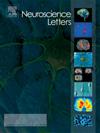Effects of Apelin-13 on auditory system in STZ-induced diabetic rats
IF 2.5
4区 医学
Q3 NEUROSCIENCES
引用次数: 0
Abstract
Aim
Damage to the auditory pathways is one of the complications of diabetes. The aim of this study was to investigate the potential therapeutic effects of apelin-13 in the auditory pathways of rats with experimentally induced diabetes by examining its effect on auditory brainstem responses, cochlear oxidative stress and inflammatory cytokines.
Methods
Thirty-two male Wistar albino rats were divided into four groups: sham control, diabetes, apelin and diabetes + apelin. A single dose of 45 mg/kg streptozotocin (STZ) was administered to induce diabetes. The apelin group received 50 µg/kg apelin-13 for seven days intraperitoneally (ip). At the end of the apelin and STZ applications auditory brainstem responses (ABR) was recorded. At the end of the experiment, cochlea was removed and biochemical analyzes were performed.
Results
In ABR recordings, the latencies of wave V in diabetic group were observed to be longer than those of the control, with the apelin treatment exhibiting a partial reversal of this situation, particularly at specific frequencies and intensity levels. Apelin treatment leads to a significant increase in total antioxidant status (TAS) and a reduction in total oxidant status (TOS) and oxidative stress index (OSI) in cochlea compared to diabetic groups. The levels of tumor necrosis factor-alpha (TNF-alpha) and interleukin 1-beta (IL-1 beta) in cochlear tissue were found to be significantly reduced in the apelin-treated group compared to the diabetic group.
Conclusion
Apelin-13 may have a protective effect on the auditory system and may be proposed as a potential new therapeutic strategy for the management diabetic auditory impairment.
Apelin-13 对 STZ 诱导的糖尿病大鼠听觉系统的影响
目的:听觉通路受损是糖尿病并发症之一。本研究旨在通过研究凋亡素-13对听觉脑干反应、耳蜗氧化应激和炎症细胞因子的影响,探讨其对实验性糖尿病大鼠听觉通路的潜在治疗作用:将 32 只雄性 Wistar 白化大鼠分为四组:假对照组、糖尿病组、apelin 组和糖尿病 + apelin 组。给大鼠注射单剂量 45 毫克/千克链脲佐菌素(STZ)诱发糖尿病。阿佩林组腹腔注射50微克/千克阿佩林-13,连续七天(ip)。凋亡素和 STZ 应用结束后,记录听性脑干反应(ABR)。实验结束后,取出耳蜗并进行生化分析:结果:在 ABR 记录中,观察到糖尿病组 V 波的潜伏期比对照组长,阿佩林治疗可部分逆转这种情况,特别是在特定频率和强度水平。与糖尿病组相比,杏仁蛋白治疗可显著提高耳蜗的总抗氧化状态(TAS),降低总氧化状态(TOS)和氧化应激指数(OSI)。与糖尿病组相比,杏仁蛋白治疗组耳蜗组织中肿瘤坏死因子-α(TNF-α)和白细胞介素 1-β(IL-1β)的水平显著降低:Apelin-13可能对听觉系统有保护作用,可作为治疗糖尿病听觉损伤的一种潜在的新治疗策略。
本文章由计算机程序翻译,如有差异,请以英文原文为准。
求助全文
约1分钟内获得全文
求助全文
来源期刊

Neuroscience Letters
医学-神经科学
CiteScore
5.20
自引率
0.00%
发文量
408
审稿时长
50 days
期刊介绍:
Neuroscience Letters is devoted to the rapid publication of short, high-quality papers of interest to the broad community of neuroscientists. Only papers which will make a significant addition to the literature in the field will be published. Papers in all areas of neuroscience - molecular, cellular, developmental, systems, behavioral and cognitive, as well as computational - will be considered for publication. Submission of laboratory investigations that shed light on disease mechanisms is encouraged. Special Issues, edited by Guest Editors to cover new and rapidly-moving areas, will include invited mini-reviews. Occasional mini-reviews in especially timely areas will be considered for publication, without invitation, outside of Special Issues; these un-solicited mini-reviews can be submitted without invitation but must be of very high quality. Clinical studies will also be published if they provide new information about organization or actions of the nervous system, or provide new insights into the neurobiology of disease. NSL does not publish case reports.
 求助内容:
求助内容: 应助结果提醒方式:
应助结果提醒方式:


